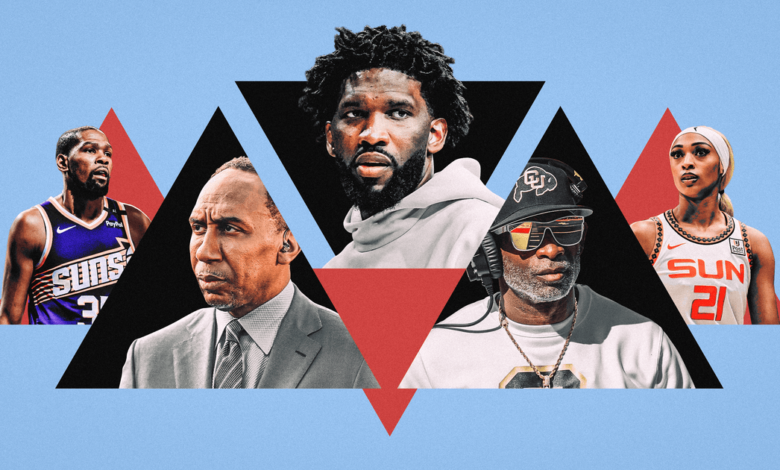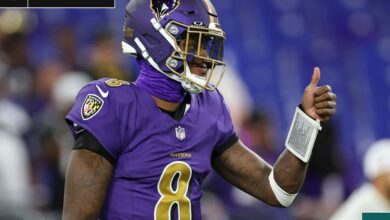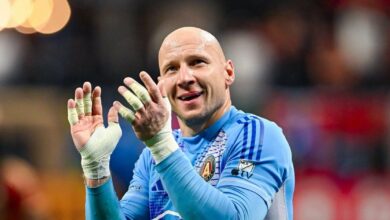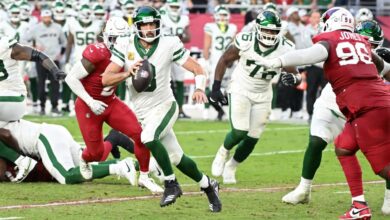Joel Embiid’s incident is a microcosm of the loss of respect for each other in our society

Joel Embiid’s postgame media drama went off without a hitch in New York on Tuesday night following the Philadelphia 76ers’ loss to the Knicks. There was no emotional confrontation between him and a reporter, unlike the week before, when he berated and pushed a Philadelphia Inquirer columnist for writing a piece that he said crossed the line between professional and personal commentary.
Clean-ups between professional athletes and reporters are as old as the games themselves, with the earliest known high-profile incident dating back to 1907 and baseball great Ty Cobb. But something felt different about the incident between Embiid and columnist Marcus Hayes, who angered the 7-foot All-Star center by mentioning Embiid’s son and late brother in a piece criticizing Embiid’s conditioning and dedication.
I couldn’t put my finger on it until I stepped back to get a macro view. It was then that I realized that the altercation itself wasn’t the thing gnawing at me. That’s what the incident represented: another strong indicator that the decline in decorum and respect throughout society is seeping deeper into the fabric of the sport.

The thought first occurred to me in April. LSU was preparing to face UCLA in the NCAA women’s basketball tournament and the Los Angeles Times published a story characterizing LSU’s players, led by All-America front court star Angel Reese, as “dirty rookies” and UCLA as “America’s sweethearts.” The only thing worse than the coded language was the fact that someone actually thought it was a good idea to publish it.
The same goes for Hayes’ column, which initially began with the following passage: “Joel Embiid consistently points to the birth of his son Arthur as the major turning point in his basketball career. He often says he wants to be great to leave a legacy for the boy named after his little brother, who tragically died in a car accident when Embiid was in his first year as a 76er. Well, to be good at your job, you have to show up for work first.”
Hayes later apologized in a social media post and rewrote the passage to remove any mention of Embiid’s family, similar to how the Los Angeles Times and its writer apologized and removed the offensive language from their story. Still, it’s hard to read comments like this and wonder if we’ve lost respect for each other.
Nowadays, people seem to feel more comfortable saying out loud what they used to only say in private. The quiet part is no longer meant to be quiet. And to the extent that sports is a microcosm of society, it was only a matter of time before the temperature in reporter-athlete relationships would rise.
“You read that exactly right,” said Dr. Harry Edwards, the respected sociologist, social activist and professor. “Sport inevitably and inevitably recapitulates the structure and dynamics of human and institutional relations in society and the ideological definitions that define and rationalize these relations. You go back and look at the history of athletes and the sports media, really the media in general, and there has always been a tension there that most people considered healthy. They looked at the mainstream media and the powers that be, and the expectation was that the media would speak the truth to those in power and report accurately to the people. But the tension we see today is different.”
Stephen A. Smith responds to Kevin Durant calling him a ‘clown’: ‘I won’t disrespect him the same way he disrespects me. It’s a shame that no matter how old he gets, his sensitivity seems to increase and his maturity doesn’t. But that’s something he has to deal with… pic.twitter.com/nzujKIJUyU
— Terrible announcement (@awfulannouncing) November 4, 2024
That’s not to say that physical altercations between athletes and reporters are a new phenomenon. The timeline of the past five decades includes the Los Angeles Rams quarterback Jim Everett turns a table on talk show host Jim Rome Atlanta Braves outfielder Deion Sanders pour a bucket of ice water over the head of baseball analyst Tim McCarver, Boston Red Sox slugger Jim Rice ripping baseball writer Steve Fainaru’s shirt, San Diego Chargers quarterback Jim McMahon deliberately blowing snot on beat writer TJ Simers, and Chargers cornerback Elvis Patterson, in a separate incident, He sneaks up on Simers from behind and puts a garbage bag over his head before trying to throw him into the shower.
And let’s not forget Buffalo Sabers goaltender Dominik Hasek pushing a columnist, Texas Rangers pitcher Kenny Rogers pushing two cameramen and throwing one of the cameras to the ground, Cleveland outfielder Albert Belle throwing a baseball and intentionally hitting a photographer , and New England Patriots cornerback Raymond Clayborn gets physical with Boston Globe columnist Will McDonough, but unfortunately finds out McDonough was just as skilled with his fists as he was with his pen.
But relatively speaking, these types of arguments are outliers. Whether it will remain that way is up for debate. Star players make so much money these days that the threat of a fine or suspension is no longer the deterrent it once was. And with technological advances seemingly turning anyone with a working camera phone into “media,” the line between what is and isn’t appropriate for print is as blurred as it has ever been.

Free, daily sports updates straight to your inbox.
Free, daily sports updates straight to your inbox.
To register
“There were things you just didn’t write about in the past,” Edwards said. “The rationalization was, ‘What does that have to do with tomorrow night’s game?’ He is not suspended, he is playing, so we are not going to write about that. We’re going to concentrate on the game.’ But nowadays there is so much media attention and anyone who has a camera phone is a reporter, so the lines are going to blur. That breaks the historical relationship.”
We are then left with a heightened culture of hostility that affects every level of sports reporting. In the past year alone, we’ve seen ESPN media personality Stephen A. Smith call Phoenix Suns star Kevin Durant a liar after Durant publicly called him a “clown.” We’ve seen Sanders, now head football coach at Colorado, accuse reporters of “going on the attack” because some of them make less than NIL-enriched players. We saw LSU women’s basketball coach Kim Mulkey threaten to sue a reporter as a preemptive strike on a planned profile. And we’ve seen the WNBA Players Association demand the revocation of Christine Brennan’s media credentials after she accused the USA Today columnist of being ‘unprofessional’ and ‘abusing’ her ‘privileges’ in an interview with Connecticut Sun’s DiJonai Carrington.
“There was once a time when you college players never attacked, now they make more money than you and some of you are jealous and jealous of that, so you’re on the offensive.”
Deion Sanders had a few words for CFB reporters during today’s press conference 😳 pic.twitter.com/AYqsTAv7yl
— FOX College Football (@CFBONFOX) September 17, 2024
Unfortunately, sometimes media guardrails are missing, further complicating an already complicated relationship. It’s no surprise that professional athletes are calling louder for safe spaces for reporters. The NFLPA has already floated the idea closing the locker room on non-game days, and 76ers star Paul George has made it clear he prefers one media free locker room after the match.
But here we come full circle. Restricting access not only makes it harder for reporters to get to know athletes on a personal level, but also makes it easier to be critical of them. And if it’s easier to be critical of them, it can lead to more arguments, especially when professionalism seems to be declining rapidly.
“It’s terrible, but this is where we are and, more than that, this is who we are,” Edwards said. “And that will be a terrible situation to deal with.”
(Top image: Meech Robinson and Dan Goldfarb / The Athletics; Photos, from left, via Getty Images; Barry Gossage/NBAE; Paras Griffioen; Mitchell Leff; Patrick Mulligan; Alika Jenner)




